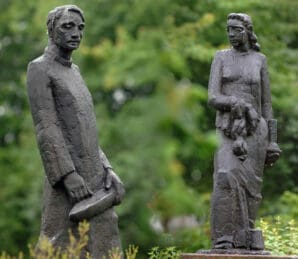THE WEAVER AND THE KNITTER (WERNER HEYNDRICKX)
In a flowerbed near the city library are two bronze statues of modest size. They refer to the former working class of Sint-Niklaas, a city in which the textile industry flourished from the 19th until well into the 20th century. Almost all the knitwear factories and weaving mills have now left the city.
The sculptures "The Weaver and the Breister" are a reminder of this bygone industrial era, which has not only glory but also misery. These working people are not portrayed heroically as is the case in social realism. They are simple, closed in form and somewhat introverted. They bear their daily cares without resistance. They are grand in their modesty.
The stylized design refers to expressionism. Werner Heyndrickx comes from a family of stone cutters and is therefore an excellent craftsman. One of his notable statements is that a good sculpture should be able to roll down a mountain without a piece breaking off. A sculpture should be comparable to a menhir or a dolmen because of its compactness.
The artist is known as a skilled portraitist. He was an ardent supporter of expressionism in his youth. He regularly returned to that childhood love during his career. The "Weaver and the Breister" are the last works he realizes commissioned by the city government.
HEYNDRICKX Werner (1909-1986)
Werner Heyndrickx is a realist sculptor of portraits and figures. Educated at the academies of Sint-Niklaas and Antwerp and at the National Institute of Fine Arts in Antwerp (atelier E. Wijnants). Teacher of sculpture at the Municipal Academy of Fine Arts in Sint-Niklaas and the Higher Institute in Antwerp (1965).
Prizes: the 'Godecharle Prize', the 'Van Lerius Prize', the 'Doutrolonde de Try Prize' and the 'Prize of the Province of East Flanders for Sculpture'.
1980

